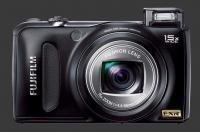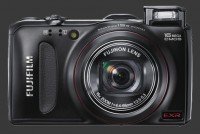Fujifilm Finepix F550 EXR Review
Fujifilm Finepix F550 EXR Performance - How well does it take pictures?
The EXR technology used by the Fuji Finepix F550 EXR is extremely capable, with each mode delivering outstanding results in some way. While the baseline HR results of the F300 where excellent and the SN and DR modes enhanced things further, the new EXR BSI-CMOS sensor used in the F550 EXR produces results which are reasonable but not class-leading in HR mode. In SN mode things are much improved and in DR mode as well, only differently.
Starting with Resolution Priority (HR) mode, image noise is minimal at ISO 100 but shows up at 200. It slowly increased until ISO 800 where results remain usable for mid-sized prints. ISO 1600 shows considerably more softness and settings beyond that are of limited use. In Low-Noise Priority (SN) mode, images show very little noise until ISO 800 while remaining quite sharp. ISO 1600 shows a bit of softness but remains very usable for most common print sizes. In Dynamic Range Priority (DR) mode, noise levels are somewhere in between but closer to SN mode. There, noise-levels increase steadily but without much softness even until ISO 3200, the maximum allowable sensitivity. Certainly, ISO 100 to 400 settings are completely usable for mid-to-large prints in DR mode.
The F550 EXR has another trick to fight image noise: Pro Low-Light mode. This mode uses multi-frame noise-reduction to produce a single clear image from a burst of 4 frames. The table below illustrate the differences between all 4 modes at ISO 3200. Note that Pro Low-Light improves even over EXR-SN mode.
 ISO 3200 EXR-HR ISO 3200 EXR-HR |
 ISO 3200 - EXR-SN ISO 3200 - EXR-SN |
 ISO 3200 - Pro Low-Light ISO 3200 - Pro Low-Light |
 ISO 3200 - EXR-DR ISO 3200 - EXR-DR |
The F550 EXR has six settings for dynamic-range: 100%, 200%, 400%, 800%, 1600% and Auto. Auto simply chooses among the other four settings depending on the current ISO sensitivity and several metering points. This means that Auto ISO cannot obviously choose a DR setting which is not available at the set ISO and that it can choose the wrong setting if the metering points do not detect the scene's entire dynamic-range. This may happen for example if there are very bright spots near the edges of the frame. The 800% and 1600% settings are only available for images shot in EXR-DR mode and are limited to 8 megapixels.
 100% DR 100% DR |
 200% DR 200% DR |
 400% DR 400% DR |
 800% DR 800% DR |
 1600% DR 1600% DR |
Expanded dynamic-range is extremely useful for outdoor photography where the sky easily gets over-exposed in order to main subject-details. Anyone who has been on a general-interest tour probably suffered from visiting places when the light was too contrasty to obtain nice results. There are travel photography tours which plan for this and bring visitors to the right places at the ideal time of day.
The lens on this digital camera is an impressive achievement. Fuji managed to pack an ultra-wide 15X optical zoom lens in a 1.3" (33mm) thick body by using a double sliding-lens design. This takes on the original work Pentax used to fit a digital camera in a box of Altoid mints one step further. The principle is that while the lens retracts into the camera, two elements slide out of the way. Note that this is different than folded-optics which uses a prism to bend the optical path.
Optical distortion is nearly invisible. This is very impressive as only a very slight amount of barrel distortion can be seen at the widest setting. Equally impressive is that no vignetting can be seen throughout the entire optical zoom range. Another miracle is that we did not find any chromatic aberrations with this lens either. This has historically been a weak point for Fuji.
The weak point of this otherwise awesome lens is strong softness near the edges of images depending on the focal-length. Towards the wide-angle side edge softness varies between moderate to very pronounced. Strangely, zooming-in increases edge softness even more before things start to improve. Then, as the camera approaches normal focal-lengths, softness disappears completely. Our review unit was softer on the lower right corner which may be an issue of quality control.

Color on the Fuji F550 is controlled by Film-Simulation: Provia, Velvia, Astia, B&W or Sepia. Provia is the default setting with natural but gently oversaturated colors. The Velvia setting boosts saturation across all colors giving a more punchy rendering without being over-the-top. Astia is the softest setting with some slight oversaturation compared to reality, it does show more gentle contrast though. The automatic white-balance system of the F550 EXR is very good though, rarely leaving a color-cast. It even handles artificial lighting surprisingly well. Custom white-balance is quite good not not perfect. The difference can be measured but it hard to see visually.
The metering system is good and manages to balance shadows and highlights very well. This is certainly helped by this camera's exceptional dynamic range. In high-dynamic range mode, it is surprisingly difficult to make it burn-out highlights. This is the most impressive and advantageous of all EXR modes. One thing that users will need to know is that the dynamic range captured by the Fuji F550 EXR is still greater than what can be shown on the camera's LCD screen. This means it is possible that highlights look blown-out in the preview.
The Fuji Finepix F550 does everything fast. Startup is quick and so are focusing and zooming. While not having the F300 EXR's ultra-fast phase-detection autofocus, the F550 EXR is one of the fastest focusing compact cameras to date. It locks focus quickly, down to relatively low light levels. The all-important shutter-lag is nearly instant. Shot-to-shot speeds are excellent at under 1s. In Playback mode, everything is quite fast, even zooming-in on images.

This digital camera has image stabilization which proved extremely effective at all focal lengths. At both ends of the zoom, there is roughly a 3-stop advantage over the usual hand-held rule-of-thumb. Note that this camera generally prefers to increase the ISO, when the ISO is set to automatic, than to lower the shutter-speed and let the stabilizer handle it. Luckily, there are several automatic ISO modes which allow the user to choose an ISO limit from 400 to 3200. This lets users select which is the highest acceptable ISO.
With the CMOS sensor comes new high-performance burst modes. The Fuji Finepix F550 EXR can shoot at 3, 5, 8 or 11 FPS. It can also sustain this for 4, 8, 16 or 32 JPEG images. When shooting RAW, the burst depth is always 6. Here this camera shows some bizarre feature interaction:
- At 16 megapixels, shooting rate is limited to 8 FPS or slower
- At 8 FPS, the dynamic range is limited to 100%
- At 8 megapixels or less, a rate of 11 FPS can be achieved
- A buffer depth of 16 frames requires 8 MP or less and a DR of 100%
- A buffer depth of 32 frames requires 4 MP and a DR of 100%
Continuous shooting starts with a disturbing display lag of 1½s before the display starts to follow the action very choppily. This makes following action on the difficult side. It can take several seconds to store a long burst but the F550 lets the process be interrupted by pressing the back button. In playback mode, Fuji added some sophistication to accommodate groups of continuously shot images. Bursts can be seen as a short looping animation and deleted as a whole or one can enter into the burst to play and delete individual images within a burst.
With a battery-life of 300 shots per charge, the F550 EXR gives in an average performance for a modern compact digital camera. Using a GPS puts extra stress on the battery since it needs to be working even between shots and, optionally, while the camera is powered off. This means you have to keep shooting to get those 300 shots per charge, otherwise the GPS will drain the battery. The Auto-EXR mode also seems to eat up an extra percentage of battery power, constantly scanning and focusing. Still, a single battery can easily last through a day of shooting.
Fujifilm Finepix F550 EXR Performance - How well does it shoot video?
The Fuji F550 EXR can capture full HD videos thanks to its high-speed CMOS sensor. At the highest resolution, this digital camera captures 1080p video with stereo sound using a built-in microphone. A frame rate of 30 FPS is used for both 1080p and 720p HD video recording. There is also a VGA (640p) mode which can be recorded at a standard 30 FPS or a high-speed 80 FPS. Lowering the resolution further lets it capture videos up to 160 FPS for QVGA (320x240) or 320 FPS for the very odd resolution of 320x112.
Zooming is possible during video recording. The lens moves very slowly to avoiding making noise while sound is being recorded. Autofocus can be fixed at the first frame or continuous using the central focus-point. The continuous autofocus lags behind action and takes time to settle, so it is preferable to avoid using it. Camera movements are problematic as it can take over one second for the camera to refocus itself after the camera is moved.

The video quality is quite good with crisp details and fluid motion. The H.264 codec is used to store videos in Quicktime format and shows virtually no compression artifacts. As mentioned earlier in this review, video recording starts with only a short delay and stops instantly. There are guidelines that help setting up framing and this time, unlike the blue ones of the F300 EXR, are accurately placed for HD video recording. The only impossible to frame video mode is the 320x112 one since the guidelines are always in the HD position and do not reflect the currently selected video mode.
Fujifilm Finepix F550 EXR Conclusion
The Fuji Finepix F550 EXR pushes the limits of its form-factor by offering a 16 megapixels BSI-CMOS sensor and an ultra-wide 15X optical zoom lens in a 1.3" thick body. This camera packs a very complete feature set including full manual-controls, custom white-balance, spot-metering, bracketing, 1080p HD video with stereo sound, a built-in GPS and RAW capture. No current compact camera has all these, although a rare few have features not found in this Fuji.

At its maximum resolution, image noise is on the high side but its special EXR CMOS-sensor lets it capture an incredible dynamic-range or very low-noise images at 8 megapixels. With exception to noise at 16 megapixels, the Fuji F550 EXR turns in a very solid performance. Exposure, color, white-balance and focus are all quite accurate and reliable. This camera focuses very fast and remains quite responsive during most operations. The all-important shutter-lag is excellent and so is the shot-to-shot speed.
Compared to its predecessor, the F550 EXR mostly adds 1080p video and a built-in GPS. This comes at the expense of both image quality and focusing speed, so one has some compelling reasons to choose the Fujifilm Finepix F300 EXR
Fujifilm Finepix F300 EXR instead. To find a similar feature set in a compact digital camera is nearly impossible unless seriously reducing the zoom range and losing the GPS.
 |
Please Support Neocamera
All information on Neocamera is provided free of charge yet running this website is a huge endeavor. Purchases made via affiliate links found throughout the site help keep it running and up-to-date. There is no additional cost to you, so please consider buying via these links to our affilates:
If you found any information on this site valuable and did not purchase via our affiliate links, please considering donating via PayPal:
Any amount will be greatly appreaciated. Thank you for your support!
Fujifilm F550 EXR Highlights

Sensor-Size: 6 x 5mm

Actual size when viewed at 100 DPI
| 16 Megapixels Travel Zoom | ISO 100-3200 |
| 15X Ultra-Wide Optical Zoom | Shutter 1/2000-8s |
| Built-in Stabilization | Full manual controls |
| 8 FPS Drive, 8 Images | Custom white-balance |
| 1920x1080 @ 30 FPS Video Recording | Spot-Metering |
| 3" LCD 460K Pixels | Lithium-Ion Battery |
| Secure Digital Extended Capacity |
Built-In GPS
The Fuji Finepix F550 EXR includes a built-in GPS receiver. When enabled and a the GPS position is known, the camera records the location inside images. This is usually known as geotagging. This camera also includes a location database which is used to give a name to the location, rather than just coordinates.

In playback mode, as shown above, the location name can be used to confirm the approximate accuracy of the GPS. The database is surprisingly precise and not only knows the name of buildings but also which door is closest.
The way GPS works, it always takes a while to establish a location at first. This is called the Time-To-First-Lock (TFL). Subsequent changes are usually faster because the camera can assume it has not moved much since the last time. If a photo has been taken before the TFL, then it cannot be tagged. To deal with this at the expense of battery-life, the F550 EXR optionally allows the GPS to constantly check its position while the camera is off.
The GPS in this digital camera takes several minutes to initially lock but keeps up rather well after that. It also appears to be quite sensitive, even managing to pin-point a location under moderate obstructions. It also is not extremely power-hungry and the camera will turn it off automatically when power is low, not to rundown the battery before taking any pictures!
An onscreen indicator shows the status of the GPS and the strength of the signal. We assume there is a correlation between signal strength and its accuracy. GPS coordinates are displayed instead of place names, if no place is found in the location database.
The GPS is put to good use in Playback mode. The camera can search and create slide-shows based on location. It can do that using a specific location such as a landmark or public building. It can also search using a broader location such as a city. Even neater, the Fuji Finepix F550 EXR can direct you to the location a photo was taken using an onscreen compass and distance indicator.
Updates
2025.01.18

Fujifilm GFX 2025 Lens Roundup
Lens Review roundup of Fujifilm GFX Medium-Format lenses. Quality, performance and handling of the GF20-35mm F/4R WR, GF30mm F/3.5 Tilt-Shift and the GF55mm F/1.7.
2024.11.18

Best 2024 Photography Gifts for Every Budget
Great gifts for photographers and photo enthusiasts selected for every budget among the best products of 2024.
2024.08.07

Eye Protection Tips for Professional Photographers
The four main considerations for professional photographers regarding eyewear.
2024.07.14

Fujifilm X100VI Review
Flagship fixed-lens compact digital camera with a 40 MP sensor and Image-Stabilization, a first for the series. Retro design featuring dual control-dials, plus direct ISO, Shutter-Speed and EC dials. Its hybrid viewfinder can switch between EVF and OVF mode.
2024.05.09

Fujifilm GFX100 II Review
Flagship 102 Megapixels Medium-Format Mirrorless Digital Camera with 8-Stop 5-Axis IBIS, 8 FPS Drive, 8K Video and 400 MP Super-Resolution capture in a weatherproof and freezeproof body with dual control-dials and dual memory-card slots.
2024.04.03

Fujifilm X-T5 Review
Newest Fujifilm flagship boasting a 40 MP APS-C sensor, 5-axis IBIS with 7-stop efficiency, 15 FPS continuous drive, 6.2K Video capture, dual control-dials and dual SDXC UHS-II slots in a sturdy weatherproof and freezeproof body.
2023.11.20

Best Digital Cameras of 2023
Find out which are the Best Digital Cameras of 2023. All the new Mirrorless Digital Cameras from entry-level to high-end professional.
2023.07.10

Fujifilm X-H2 Review
40 Megapixels APS-C Hybrid Mirrorless Digital Camera with 7-stop IBIS. Fastest shutter ever and 8K video capture. Large builtin EVF with 0.8X magnification and 5.8 MP, plus an Eye-Start Sensor. Packed with features and large number of controls in a weatherproof and freezeproof body.
2023.05.07

Sony FE 20-70mm F/4G Review
Review of the unique Sony FE 20-70mm F/4G lens. The optical zoom of this lens spans ultra-wide-angle and medium focal-length coverage, making it one of the most versatile Full-Frame lenses on the market.
2023.01.15

Huion Inspiroy Dial 2 Review
Review of the Huion Inspiroy Dial 2 tablet, a medium sized drawing surface with dual dials and customizable buttons. Connects via USB-C or Bluetooth 5.0 with Windows, Linux and Android support.
2022.12.08

How to Pack for a Photo Trip
Find out how to pack for a travel photography trip, carry your gear safely while meeting airline regulations.
2022.11.13

Best Digital Cameras of 2022
The best digital cameras of 2022. A short list of the most outstanding models in their respective categories. Choose one for yourself or as a gift.













